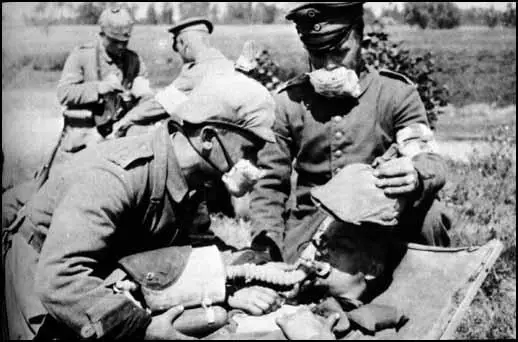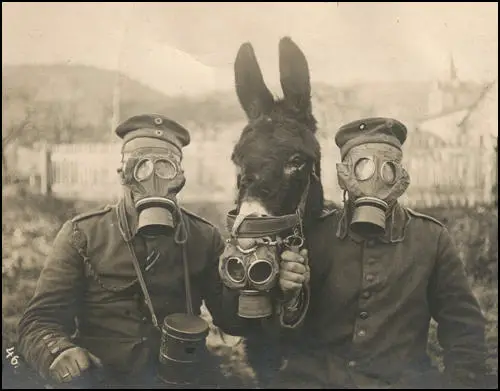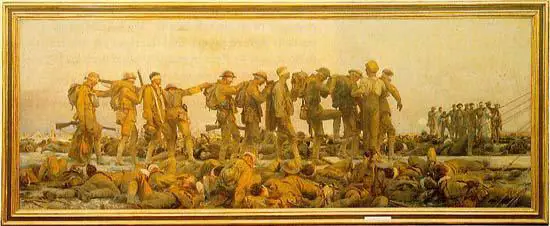Poison Gases in the First World War
Poisonous gases were known about for a long time before the First World War but military officers were reluctant to use them as they considered it to be a uncivilized weapon. The French Army were the first to employ it as a weapon when in the first month of the war they fired tear-gas grenades at the Germans.
In October 1914 the German Army began firing shrapnel shells in which the steel balls had been treated with a chemical irritant. The Germans first used chlorine gas cylinders in April 1915 when it was employed against the French Army at Ypres. Chlorine gas destroyed the respiratory organs of its victims and this led to a slow death by asphyxiation.
General William Robertson recommended Brigadier General Charles Howard Foulkes to General John French as the best man to organise the retaliation. Foulkes accepted the post he eventually received the title of General Officer Commanding the Special Brigade responsible for Chemical Warfare and Director of Gas Services. He worked closely with scientists working at the governmental laboratories at Porton Down near Salisbury. His biographer, John Bourne, has argued: "Despite Foulkes' energy, the ingenuity of his men and the consumption of expensive resources, gas was ultimately disappointing as a weapon, despite its terrifying reputation."

It was important to have the right weather conditions before a gas attack could be made. When the British Army launched a gas attack on 25th September in 1915, the wind blew it back into the faces of the advancing troops. This problem was solved in 1916 when gas shells were produced for use with heavy artillery. This increased the army's range of attack and helped to protect their own troops when weather conditions were not completely ideal.
After the first German chlorine gas attacks, Allied troops were supplied with masks of cotton pads that had been soaked in urine. It was found that the ammonia in the pad neutralized the poison. Other soldiers preferred to use handkerchiefs, a sock, a flannel body-belt, dampened with a solution of bicarbonate of soda, and tied across the mouth and nose until the gas passed over. It was not until July 1915 that soldiers were given efficient gas masks and anti-asphyxiation respirators.
One disadvantage for the side that launched chlorine gas attacks was that it made the victim cough and therefore limited his intake of the poison. Both sides found that phosgene was more effective poison to use. Only a small amount was needed to make it impossible for the soldier to keep fighting. It also killed its victim within 48 hours of the attack. Advancing armies also used a mixture of chlorine and phosgene called 'white star'.
Mustard Gas (Yperite) was first used by the German Army in September 1917. The most lethal of all the poisonous chemicals used during the war, it was almost odourless and took twelve hours to take effect. Yperite was so powerful that only small amounts had to be added to high explosive shells to be effective. Once in the soil, mustard gas remained active for several weeks. The Germans also used bromine and chloropicrin.
In July 1917, David Lloyd George appointed Winston Churchill as Minister of Munitions and for the rest of the war, he was in charge of the production of tanks, aeroplanes, guns and shells. Clive Ponting, the author of Churchill (1994) has argued: "The technology in which Churchill placed greatest faith though was chemical warfare, which had first been used by the Germans in 1915. It was at this time that Churchill developed what was to prove a life-long enthusiasm for the widespread use of this form of warfare."

Churchill developed a close relationship with Brigadier General Charles Howard Foulkes. Churchill urged Foulkes to provide him with effective ways of using chemical weapons against the German Army. In November 1917 Churchill advocated the production of gas bombs to be dropped by aircraft. However, this idea was rejected "because it would involve the deaths of many French and Belgian civilians behind German lines and take too many scarce servicemen to operate and maintain the aircraft and bombs."
On 6th April, 1918, Churchill told Louis Loucheur, the French Minister of Armaments: "I am... in favour of the greatest possible development of gas-warfare." In a paper he produced for the War Cabinet he argued for the widespread deployment of tanks, large-scale bombing attacks on German civilians and the mass use of chemical warfare. Foulkes told Churchill that his scientists were working on a very powerful new chemical weapon codenamed "M Device".
According to Giles Milton, the author of Russian Roulette: How British Spies Thwarted Lenin's Global Plot (2013): "Trials at Porton suggested that the M Device was indeed a terrible new weapon. The active ingredient in the M Device was diphenylaminechloroarsine, a highly toxic chemical. A thermogenerator was used to convert this chemical into a dense smoke that would incapacitate any soldier unfortunate enough to inhale it... The symptoms were violent and deeply unpleasant. Uncontrollable vomiting, coughing up blood and instant and crippling fatigue were the most common features.... Victims who were not killed outright were struck down by lassitude and left depressed for long periods."

Churchill hoped that he would be able to use the top secret "M Device", an exploding shell that released a highly toxic gas derived from arsenic. Foulkes called it "the most effective chemical weapon ever devised". The scientist, John Haldane, later described the impact of this new weapon: "The pain in the head is described as like that caused when fresh water gets into the nose when bathing, but infinitely more severe... accompanied by the most appalling mental distress and misery." Foulkes argued that the strategy should be "the discharge of gas on a stupendous scale". This was to be followed by "a British attack, bypassing the trenches filled with suffocating and dying men". However, the war came to an end in November, 1918, before this strategy could be deployed.
It has been estimated that the Germans used 68,000 tons of gas against Allied soldiers. This was more than the French Army (36,000) and the British Army (25,000). An estimated 91,198 soldiers died as a result of poison gas attacks and another 1.2 million were hospitalized. The Russian Army, with 56,000 deaths, suffered more than any other armed force.
Brigadier General Charles Howard Foulkes published Gas: The True Story of the Special Brigade in 1934. In the book Foulkes claims that the total British casualties due to gas amounted to 181,053 of which 6,109 were fatal. However, he admitted that this did not include the men who died after the war due to the effects of gas poisoning. He added that the German Army had not published details of their gas casualties.
Poison Gas Deaths: 1914-1918 | |||
|---|---|---|---|
| Country | Non-Fatal | Deaths | Total |
| British Empire | 180,597 | 8,109 | 188,706 |
| France | 182,000 | 8,000 | 190,000 |
| United States | 71,345 | 1,462 | 72,807 |
| Italy | 55,373 | 4,627 | 60,000 |
| Russia | 419,340 | 56,000 | 475,340 |
| Germany | 191,000 | 9,000 | 200,000 |
| Austria-Hungary | 97,000 | 3,000 | 100,000 |
| Others | 9,000 | 1,000 | 10.000 |
| Total | 1,205,655 | 91,198 | 1,296,853 |
| British Gas Casualties: 1914-18 | Deaths | Non-Fatal |
|---|---|---|
| Chlorine | 1,976 | 164,457 |
| Mustard Gas | 4,086 | 16,526 |
Primary Sources
(1) In 1930 H. S. Clapham published a book of his experiences during the First World War called Mud and Khaki: The Memories of an Incomplete Soldier.
The shells came over just above the parapet, in a flood, much more quickly than we could count them. After a quarter of an hour of this sort of thing, there was a sudden crash in the trench and ten feet of the parapet, just beyond me, was blown away and everyone around blinded by the dust. With my first glance I saw what looked like half a dozen bodies, mingled with sandbags, and then I smelt gas and realised that these were gas shells. I had my respirator on in a hurry and most of our own men were as quick. The others were slower and suffered for it. One man was sick all over the sandbag and another was coughing his heart up. We pulled four men out of the debris unharmed. One man was unconscious, and died of gas later. I started at once to build up the parapet again, for we had been laid open to the world in front, but the gas lingered about the hole for hours, and I had to give up as it made me feel very sick.
(2) Robert Graves, Goodbye to All That (1929)
At Cambrin village, about a mile from the front trenches, we were taken into a ruined chemist's shop with its coloured glass jars still in the window: the billet of the four Welsh company-quartermaster-sergeants. Here they gave us respirators and field-dressings. This, the first respirator issued in France, was a gauze-pad filled with chemically treated cotton waste, for tying across the mouth and nose. Reputedly it could not keep out the German gas, which had been used at Ypres against the Canadian Division; but we never put it to the test. A week or two later came the 'smoke-helmet', a greasy grey-felt bag with a talc window to look through, and no mouthpiece, certainly ineffective against gas. The talc was always cracking, and visible leaks showed at the stitches joining it to the helmet.
Those were early days of trench warfare, the days of the jam-tin bomb and the gas-pipe trench-mortar: still innocent of Lewis or Stokes guns, steel helmets, telescopic rifle-sights, gas-shells, pillboxes, tanks, well-organized trench-raids, or any of the later refinements of trench warfare.
(3) Will Irwin, New York Tribune (27th April, 1915)
The German troops, who followed up this advantage with a direct attack, held inspirators in their mouths, these preventing them from being overcome by the fumes.
The effect of the noxious trench gas seems to be slow in wearing away. The men come out of their violent nausea in a state of utter collapse. Some of the rescued have already died from the after effects. How many of the men left unconscious in the trenches when the French broke died from the fumes it is impossible to say, since those trenches were at once occupied by the Germans.
This new form of attack needs for success a favorable wind. Twice in the day that followed the Germans tried trench vapor on the Canadians who made on the right of the French position a stand which will probably be remembered as one of the heroic episodes of this war. In both cases the wind was not favorable, and the Canadians managed to stick through it. The noxious, explosive bombs were, however, used continually against the Canadian forces and caused some losses.
(4) General John French, despatch (15th June, 1915)
All the scientific resources of Germany have apparently been brought into play to produce a gas of so virulent and poisonous a nature that any human being brought into contact with it is first paralysed and then meets with a lingering and agonising death.
Following a heavy bombardment, the enemy attacked the French Division at about 5 p.m., using asphyxiating gases for the first time. Aircraft reported that at about 5 p.m. thick yellow smoke had been seen issuing from the German trenches between Langemarck and Bixschoote. The French reported that two simultaneous attacks had been made east of the Ypres-Staden Railway, in which these asphyxiating gases had been employed.
What follows almost defies description. The effect of these poisonous gases was so virulent as to render the whole of the line held by the French Division mentioned above practically incapable of any action at all. It was at first impossible for anyone to realise what had actually happened. The smoke and fumes hid everything from sight, and hundreds of men were thrown into a comatose or dying condition, and within an hour the whole position had to be abandoned, together with about 50 guns.
(5) William Pressey was gassed on 7th June 1917 at Messines Ridge. He survived the attack and later wrote about the experience of being gassed.
I was awakened by a terrific crash. The roof came down on my chest and legs and I couldn't move anything but my head. I found I could hardly breathe. Then I heard voices. Other fellows with gas helmets on, looking very frightened in the half-light, were lifting timber off me and one was forcing a gas helmet on me. Even when you were all right, to wear a gas helmet was uncomfortable, your nose pinched, sucking air through a canister of chemicals.
I was put into an ambulance and taken to the base, where we were placed on the stretchers side by side on the floor of a marquee. I suppose I resembled a kind of fish with my mouth open gasping for air. It seemed as if my lugs were gradually shutting up and my heart pounded away in my ears like the beat of a drum. On looking at the chap next to me I felt sick, for green stuff was oozing from the side of his mouth.
To get air in my lungs was real agony. I dozed off for short periods but seemed to wake in a sort of panic. To ease the pain in my chest I may subconsciously have stopped breathing, until the pounding of my heart woke me up. I was always surprised when I found myself awake, for I felt sure that I would die in my sleep.
(6) Thomas Hardy wrote a poem when he first heard about the use of poison gas.
'Peace upon earth!' was said. We sing it,
And pay a million priests to bring it.
After two thousand years of mass
We've got as far as poison gas.
(7) Sophie Botcharsky was a Russian nurse on the Eastern Front and witnessed several German gas attacks. She wrote about it in her book, They Knew How to Die (1931).
A group of men came running with desperate speed. As they drew near we saw that their faces were yellow, and some were sick as they ran. At first we thought they were coming to us, but when we realized that they were going to run blindly by us, we shouted to know what had happened; without turning their heads, almost without seeing us, they tore past and on down the road.
Then we heard the galloping of a horse and our own ambulance, which was always on duty by the communication trenches, approached, rocking with its speed. The two student orderlies, hatless and wide-mouthed with horror, drove past, crying that everyone had been wiped out; and as they went by we saw that the ambulance was uncontrollable panic?
Finally one man paused for breath, and gasping out, "We are being poisoned like rats, the Germans are sending a fog that is following us" he went on down the road.
(8) Captain Geoffrey Donaldson, letter to his mother (16th July, 1916)
I can tell you that in the 30 minutes before the attack started, I came nearer to "having the wind up" or in other words losing my nerve than has ever the case before. At 8.30 p.m. the show started. I had all the men in the trench out of the dugouts and we all had our gas helmets on. It was like an appalling nightmare as you look like some horrible kind of demon or goblin in these masks. There were words of commands along the line from RE and then a loud hissing sound as the taps were turning on and the deadly greenish white vapour poured out of the jets and slowly blew in a great rolling cloud towards the opposite line of trenches.
(9) John Raws, letter to his sister (27th June 1916)
I have also been gassed, but only experience. We use the German gas, and let it loose in trenches, where of course, we wear our helmets. They are abominably hot and uncomfortable, and make us look like imitation wolves in a pantomine show. They consist of heavy cloth masks, with a rubber tube for the mouth, and glass goggles for the eyes. The neck end is quite open and shapeless, but you tuck it inside the collar of your tunic. One has to be pretty quick with them as the Germans may be only 100 yards away and the gas travels about 25 yards a second with a favourable wind. It moves in a dense cloud close to the ground, and being much heavier than air, fills up all trenches and holes it comes to. You see how fatal it must be to be caught in a dugout below a trench. A man without a helmet might as well stand upon the parapet (the low breastwork in front of the trench) and risk being shot.

